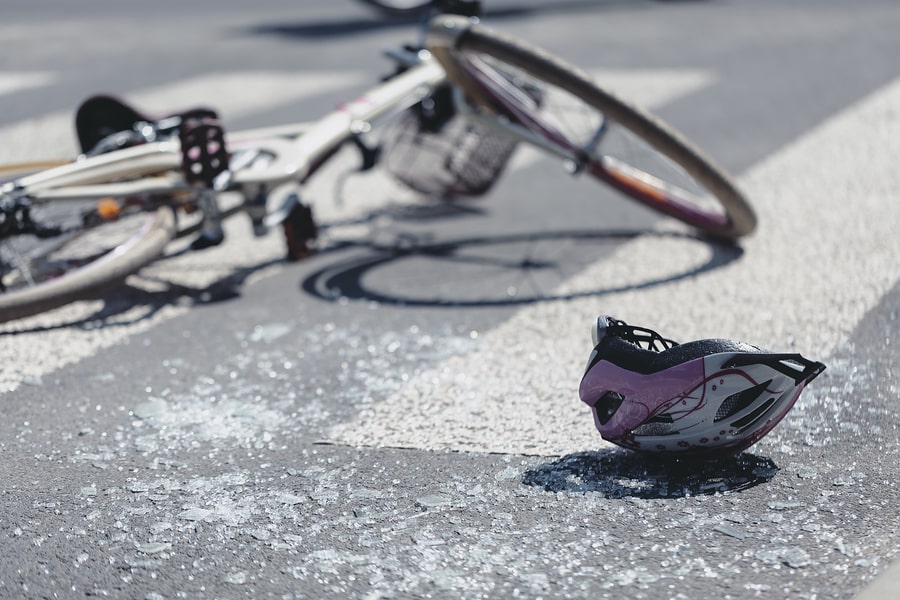
Bicycle accidents can result in very serious head and brain injuries that may leave an accident victim debilitated for years to come. In the most serious head injury cases, the accident victim can wind up permanently injured, disabled, and incapacitated. Bicycle accidents that result in serious head injuries are especially tragic because they are often entirely preventable and result from a motor vehicle operator’s carelessness and negligence.
If you or a person you love suffered a head injury in a bicycle accident, seek experienced legal counsel to represent you as soon as possible. In some jurisdictions, bicycle accident victims have as little as one year from the date of their accident to bring a personal injury claim or file a lawsuit for damages.
An experienced bicycle accident attorney in your jurisdiction can review the circumstances surrounding your accident and the injuries that you sustained. A lawyer will then file a claim on your behalf, and if the insurance company refuses to settle your case favorably, he or she can file a lawsuit against the person or persons who caused your bicycle accident. Your attorney will do everything possible to help make you whole and recover the compensation you deserve for your head injury.
What Is a Traumatic Head or Brain Injury?
A traumatic head or brain injury can occur when a blunt object strikes a person’s head, possibly puncturing the skull, or when a person’s head is subjected to a significant amount of force or a strong impact. If an object goes through the person’s skull, it can make contact with the brain and injure it directly.
In cases where a person’s head receives a significant blow, the force of the impact can cause the person’s brain to move around inside his or her skull, possibly striking the front, back, or sides of the skull. This brain movement inside the skull can disrupt or sever (fully or partially) the brain’s axons and neurons, which make up the brain’s “internal wiring.”
Traumatic head and brain injuries vary in severity, and some are more serious than others. In addition, these types of injuries can lead to both short and long-term symptoms. Some of the most common types of traumatic head and brain injuries include the following:
- Concussion – A concussion typically occurs because of a strong jolt or bump to the head, causing the brain to move back and forth rapidly inside the skull. Although a concussion does not typically result in permanent brain damage, it can lead to a loss of consciousness for a period of time.
- Brain contusion – A brain contusion is a bruise on the brain, resulting from a sudden head impact.
- Skull fracture – A skull fracture occurs when there is a crack or break in a person’s skull, usually resulting from a serious impact to the head.
- Traumatic subarachnoid hemorrhage – A traumatic subarachnoid hemorrhage, otherwise known as a TSAH, is a brain bleed that typically happens when an initial injury or impact to a person’s head causes small arteries to tear.
- Hematomas – Hematomas are blood clots that form in various locations around the brain. For example, a blood clot between the dura and the brain is a subdural hematoma, while a blood clot between the brain’s dura lining and the skull is an epidural hematoma.
- Diffuse axonal injury – A diffuse axonal injury, otherwise known as a DAI, occurs when nerve cells are sheared and stretched. A DAI occurs when an injury to the head causes the brain to move quickly inside the person’s skull, damaging the brain’s axons. Serious injuries to the axons can disrupt the brain’s ability to transmit and process information.
These traumatic head/brain injuries can also lead to both short and long-term symptoms. Short-term symptoms of head injuries include headaches and short-term memory loss. More serious traumatic brain injuries can lead to longer-term symptoms, including long-term memory loss, comas, a permanent vegetative state, and even death.
If you or a family member sustained one or more of these types of head injuries in a bicycle accident, a knowledgeable bicycle accident attorney in your jurisdiction can help you file a claim and pursue the monetary compensation that you deserve for your injury.
How Do Head Injuries Occur in Bicycle Accidents?
When it comes to motor vehicle operators on the road, bicyclists are at a significant disadvantage. While car and truck drivers have a strong outer shell of steel surrounding them at all times, bicycle riders have nothing that serves as a protective barrier while they are out riding. Bicycle operators who do not wear helmets are at the highest risk of suffering a serious head injury in an accident that involves a motor vehicle.
Even though many bicycle operators do wear helmets, these helmets can crack in an accident—especially if the force of the impact causes the bicyclist to fall from his or her bicycle onto the ground or onto another motor vehicle. Also, helmets do not prevent injuries to other body parts that a bicycle rider may suffer in an accident.
When a cyclist strikes his or her head on the ground in an accident, the sheer force of the impact may cause the cyclist to suffer a concussion or a more serious type of traumatic head/brain injury.
Common Locations and Causes of a Bicycle Accident
Bicycle accidents can occur almost anywhere that motor vehicle traffic is present, including parking lots, parking garages, and roadways (even those where a cyclist is riding in the designated bicycle lane). In many instances, these accidents occur when motor vehicle drivers are operating their vehicles in a careless, reckless, or distracted manner. The motor vehicle operator may simply be distracted and fail to notice a cyclist’s presence on or near the roadway, leading the vehicle to strike the cyclist.
Some of the most common causes of accidents wherein a motor vehicle strikes a cyclist include:
- Violating the rules of the road – Every jurisdiction has rules of the road that drivers are responsible for knowing, understanding, and following. When motor vehicle drivers violate these rules by speeding, failing to use turn signals, weaving in and out of traffic, disregarding traffic signs, and disobeying traffic control devices (like stop signs and traffic lights), they significantly increase their chances of colliding with other vehicles—including bicycles—and causing serious injuries.
- Distracted driving – When motor vehicle drivers operate their vehicles in a distracted manner, such as by texting or talking on a cell phone, using a tablet, or listening to loud music, it is very easy for them to miss smaller vehicles on the road, including bicycles. Distracted driving significantly increases the chance of a collision.
- Tailgating – When motor vehicle drivers follow other vehicles, including bicycles, too closely, it makes it much more difficult for them to slow down safely, increasing their chances of colliding with the rear of the bicycle.
- Poor road conditions – In some cases, bicycle accidents do not occur because of a motor vehicle driver’s negligence at all. Instead, these accidents occur because of poor road conditions, such as dangerous potholes and bumps in the road that have not been properly repaired. The injured bicyclist may bring a claim or lawsuit against the county, city, or other municipality who is responsible for maintaining roads in the area where the accident happened. If the accident occurs near a construction site and a construction company is responsible for maintaining the area, then the injured cyclist may file a claim or lawsuit against the construction company.
In some instances, multiple people or entities can cause a bicycle accident that leads to a head or brain injury. When that occurs, your lawyer will need to bring all potentially responsible persons or entities into the pending claim or lawsuit. A lawyer can assist you with naming all of the proper parties and promptly filing your bicycle accident claim or lawsuit.
Filing a Personal Injury Claim in a Bicycle Accident Case
For you to recover monetary compensation for a head or brain injury which you sustained in a bicycle accident, you must prove, based upon a preponderance of evidence, that the at-fault person or persons behaved unreasonably under the circumstances at the time of the accident. When a motor vehicle operator engages in distracted driving or violates some other prevailing rule of the road, for example, he or she has behaved unreasonably.
In addition to demonstrating that the at-fault person behaved unreasonably, you must also show that as a result of the bicycle accident, you suffered one or more injuries—such as a head or brain injury—and that the accident was the cause (or one of several causes) of your injury. A victim of a bicycle accident has the burden of proving these legal elements. Assuming he or she can satisfy all of the elements of a negligence claim, the victim can then pursue monetary compensation for the injuries. An experienced bicycle accident attorney in your jurisdiction can help you prove the legal elements of your claim or lawsuit and can pursue monetary compensation on your behalf.
Recovering Monetary Compensation for the Injuries You Suffered in Your Bicycle Accident
Head and brain injuries sustained in bicycle accidents can lead to serious complications and damages. In some instances, the extent of the injury might be so severe that the accident victim can no longer work or care for himself or herself.
The type and extent of the monetary damages to which victims of bicycle accidents are entitled depend upon the seriousness of the injury, the amount of medical treatment which the accident victim received for his or her injury, whether or not the injury is permanent, the lifelong impact that the injury is expected to have on the accident victim, and the anticipated costs of future medical care, rehabilitation, or treatment—such as the cost of a future surgery or lifetime care in a nursing home or assisted living facility.
Some types of potential damages for which victims with head injuries sustained in bicycle accidents may be compensated include:
- Related medical costs and expenses (even those which a person’s health insurance, Medicare, or Medicaid covers), including the costs of all medical procedures, treatment, hospital visits, doctor visits, and physical therapy visits that are related to the accident
- Time missed from work while the accident victim was recovering from his or her injuries, and/or attending medical or physical therapy appointments
- Loss of earning capacity, to the extent that the head injury prevents the accident victim from working completely or from working in the same capacity and receiving the same amount of pay as before the bicycle accident
- Anticipated costs of future surgeries or other medical treatment stemming from the head or brain injury which the accident victim suffered in the accident
- Anticipated costs of future (and sometimes lifelong) care in a treatment or rehabilitation center, assisted living center, or nursing home
- Inconvenience, pain, suffering, humiliation, and embarrassment which the accident victim had to endure as a result of the head or brain injury stemming from the bicycle accident
- Loss of spousal care, support, or companionship resulting from the injuries which the accident victim sustained
- Temporary or permanent inability to function, resulting from the head/brain injury which the accident victim sustained
An experienced bicycle accident attorney near you can assist with maximizing your damages and pursuing the monetary compensation you deserve following your head/brain injury received in a bicycle accident.
Contact a Knowledgeable Bicycle Accident Lawyer About Your Legal Matter Today
Bicycle accidents can result in some of the most serious injuries imaginable, including head and brain injuries. If you or someone you love has suffered a head or brain injury in a bicycle accident, contact a knowledgeable bicycle accident lawyer in your jurisdiction assist you with filing a claim or lawsuit, and with pursuing the damages you deserve from the at-fault person and his or her insurance company.














